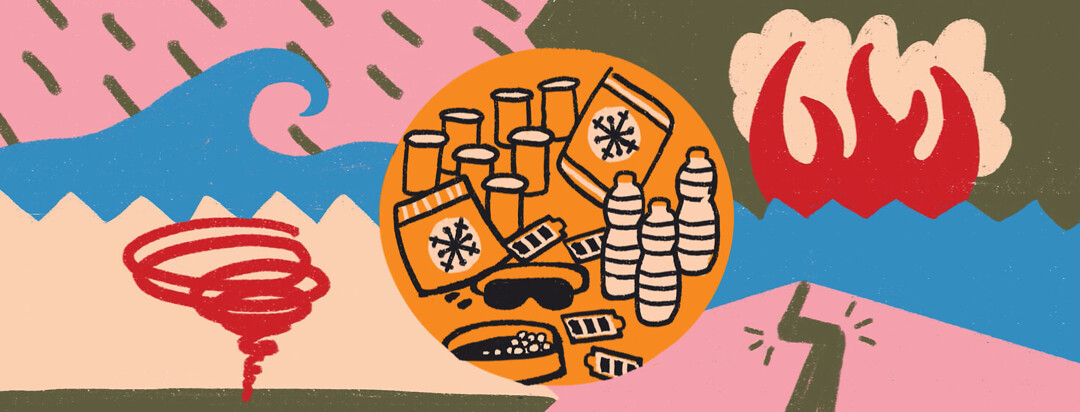How People With MS Can Prepare if Disaster Strikes
A large-scale earthquake recently struck Haiti. We're constantly reading and inundated with what this world is facing when it comes to natural disasters. Simultaneously, I found a note reminding myself to update our very own earthquake kit. I haven’t updated it since 2011, two years prior to my MS diagnosis.
A temblor isn’t the only disaster I should plan for where I live: wildfires and excessive heat remain growing concerns. These give me all the more reason to prepare to “bug out” (evacuate) in case of emergency.
Shelter in place or evacuate?
You could face two different scenarios, in which you have nowhere safe to go and must shelter in place or an opportunity to go elsewhere (evacuate) to stay safe. Both situations might last a few hours to a few days, or become mercilessly long-term (think Hurricane Katrina). Unfortunately, you won’t know which will happen until they happen.
How prepared do we need to be? I’m no prepper. Like most of you, I don’t have a fallout shelter stocked with five years’ worth of supplies. So, as a person with MS, I take my guidance from local governance. They’ve already outlined emergency preparedness measures relevant to me and my neighbors. I need only throw in a few additional MS-related items.
I already own an earthquake kit, so I’ll just update it (best done annually). It will include items for symptom relief. My kit includes a “bugout bag”, a pre-stocked backpack easy to grab for a quick evacuation. Mine needs some MS-specific items as well.
What about basic emergency preparedness?
To learn more about what your “shelter in place” kit and adjacent “bugout bag” should look like, check out the emergency preparedness web pages linked to your city, county, and state for guidance. These sites help prepare for disasters you can expect to face locally.
The US Centers for Disease Control and Prevention (1) and Canada’s Emergency Preparedness Guide (2) also offer good resources to get you started.
MS-specific emergency items
In an evacuation situation, don’t expect first aid stations to meet your needs. Plan to take these items with you, just in case:
- Spare medications: I doubt you have spare DMTs, but you should still keep handy your prescription and contact information for your specialty pharmacy and prescribing doctor. If you can keep meds on hand to treat symptoms—pain, gastrointestinal distress, sleep, as examples—you’ll thank yourself later.
- Refrigeration: If you use refrigerated medicines, plan to keep them safe and viable for both the short and long term. Know ahead of time how long they can remain effective and safe at room temperature in case the power goes out and you cannot guarantee refrigeration.
- Medical supplies: Don’t forget to keep these important items at the ready: syringes, cotton balls, alcohol wipes, catheters, prescription eyewear, and more.
- Service animal care: Keep a stash of food and supplies for your little helper ready to take in an evacuation.
- Assistive and medical devices: As you replace them with newer, better versions, keep the older ones as spares for your emergency kit. (Murphy’s Law suggests things tend to break down during a disaster!) Don’t forget other devices like PAP machines and neurostimulation therapy.
- Battery backups: Invest in portable pre-charged battery backups for your equipment just in case the power goes out.
- Cooling equipment: Pack your favorite vest, spray fans, neck wrap, wipes, and other aids for keeping cool in hot, exposed, humid conditions.
- Eye mask and earplugs: Expect fatigue in an evacuation situation. Sheltering may happen in a noisy, bright, active space. A simple eye mask and earplugs can help you shut out the world so you can sleep to recharge.
Final thoughts
It’s better to arrange certain things before disaster strikes. Establish a personal support network that includes at least three people you know and trust who agree to help you in a disaster. As well as a household emergency plan you can share across said network. It should include:
- “Check-in” arrangements
- Important notes about care needs you have, especially those not be obvious by sight
- Exchange of important keys
- Instructions for emergency supplies, documents, and health information
Anything else? A communications plan is quite important. Enlisting a third-party connection, and establish a plan for texting, phone calls, email, and social media.
Important! Find somewhere to mark your MS diagnosis and treatment information. Allow it to be easily found by your network or first responders in case you become incapacitated. Consider wearing a medical ID bracelet or dog tags, or keep medical identification in your wallet or emergency kit. Don't be shy about special needs you might have.
Helpful phone apps
Considering downloading and keeping these emergency apps uploaded and synchronized to all smartphones in your network. Remember, most only work with cell service, wi-fi connectivity, and/or power.

Join the conversation